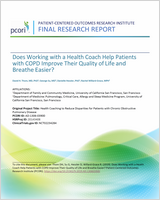|
104
| Health coaching plus action plan for exacerbations plus brief exercise advice (108) | Respiratory therapist or nurse practitioner (TM/MI) | Usual care (n = 109) | 8 wk | Measured at 6 and 12 mo:QOL: Better at 6 and 12 mo (CRQ) Hospitalizations: Fewer at 6 mo, no difference at 12 mo Exacerbations: Fewer over 12 mo
|
|
63
| Four 40-min individual training sessions at home and follow-up visits over 12 mo (232) | Registered nurse (self-regulation) | Usual care (n = 232) | 12 mo | Measured at 12 mo:QOL: no difference in total score (SGRQ) Hospitalizations: no difference in time to first hospital admission or death due to COPD Depression: no difference
|
| 97, 98 | 6-wk self-management education followed by telephone-delivered health coaching for increasing physical activity every other week for 20 wk then every other month (149) | Unknown (TM and social cognitive) | 6 wk of self-management education followed by usual care (n = 156) | 20 wk | Measured at 18 mo: |
|
101
| 2 visits to COPD clinic plus 2 individual 1-h visits for self-care education (26) | Team: COPD nurse and physician with dietician, medial social worker, and physical or occupational therapists if needed (TM/MI) | 2 visits to COPD clinic plus usual care (n = 26) | 5 mo | Measured at 5 mo:QOL: better (SGRQ) COPD knowledge: higher Current smokers: fewer
|
|
102
| Education and support for medications, inhaler use, smoking cessation, and action plans for exacerbations; 1-h visits at 0, 6, and 12 mo and telephone at 3 and 9 mo (86) | Clinical pharmacist (TM/MI) | Usual care (n = 87) | 12 mo | Measured at 12 mo: |
|
102
| Group sessions focused on COPD knowledge, self-management skills, confidence, and motivation based on Living Well With COPD Program plus 2 or 3 1:1 coaching sessions plus follow-up calls (71) | Team: pulmonologist and respiratory physiotherapist | Usual care (n = 396) | 12 mo | Measured at 12 mo: |
|
99
| MI-based training, home visits and telephone calls, action planning to achieve goals (55) | Community health nurse (TM/MI) | Usual care (n = 51) | 12 mo | Measured at 12 mo:QOL: no difference in total score (SF-36) Dyspnea: no difference (MRC) Hospitalizations: no difference
|
